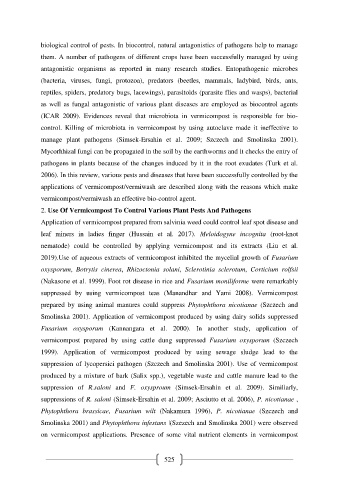Page 535 - e-Book
P. 535
biological control of pests. In biocontrol, natural antagonistics of pathogens help to manage
them. A number of pathogens of different crops have been successfully managed by using
antagonistic organisms as reported in many research studies. Entopathogenic microbes
(bacteria, viruses, fungi, protozoa), predators (beetles, mammals, ladybird, birds, ants,
reptiles, spiders, predatory bugs, lacewings), parasitoids (parasite flies and wasps), bacterial
as well as fungal antagonistic of various plant diseases are employed as biocontrol agents
(ICAR 2009). Evidences reveal that microbiota in vermicompost is responsible for bio-
control. Killing of microbiota in vermicompost by using autoclave made it ineffective to
manage plant pathogens (Simsek-Ersahin et al. 2009; Szczech and Smolinska 2001).
Mycorhhizal fungi can be propagated in the soil by the earthworms and it checks the entry of
pathogens in plants because of the changes induced by it in the root exudates (Turk et al.
2006). In this review, various pests and diseases that have been successfully controlled by the
applications of vermicompost/vermiwash are described along with the reasons which make
vermicompost/vermiwash an effective bio-control agent.
2. Use Of Vermicompost To Control Various Plant Pests And Pathogens
Application of vermicompost prepared from salvinia weed could control leaf spot disease and
leaf miners in ladies finger (Hussain et al. 2017). Meloidogyne incognita (root-knot
nematode) could be controlled by applying vermicompost and its extracts (Liu et al.
2019).Use of aqueous extracts of vermicompost inhibited the mycelial growth of Fusarium
oxysporum, Botrytis cinerea, Rhizoctonia solani, Sclerotinia sclerotum, Corticium rolfsii
(Nakasone et al. 1999). Foot rot disease in rice and Fusarium moniliforme were remarkably
suppressed by using vermicompost teas (Manandhar and Yami 2008). Vermicompost
prepared by using animal manures could suppress Phytophthora nicotianae (Szczech and
Smolinska 2001). Application of vermicompost produced by using dairy solids suppressed
Fusarium oxysporum (Kannangara et al. 2000). In another study, application of
vermicompost prepared by using cattle dung suppressed Fusarium oxysporum (Szczech
1999). Application of vermicompost produced by using sewage sludge lead to the
suppression of lycopersici pathogen (Szczech and Smolinska 2001). Use of vermicompost
produced by a mixture of bark (Salix spp.), vegetable waste and cattle manure lead to the
suppression of R.saloni and F. oxysproum (Simsek-Ersahin et al. 2009). Similiarly,
suppressions of R. saloni (Simsek-Ersahin et al. 2009; Asciutto et al. 2006), P. nicotianae ,
Phytophthora brassicae, Fusarium wilt (Nakamura 1996), P. nicotianae (Szczech and
Smolinska 2001) and Phytophthora infestans |(Szezech and Smolinska 2001) were observed
on vermicompost applications. Presence of some vital nutrient elements in vermicompost
525

